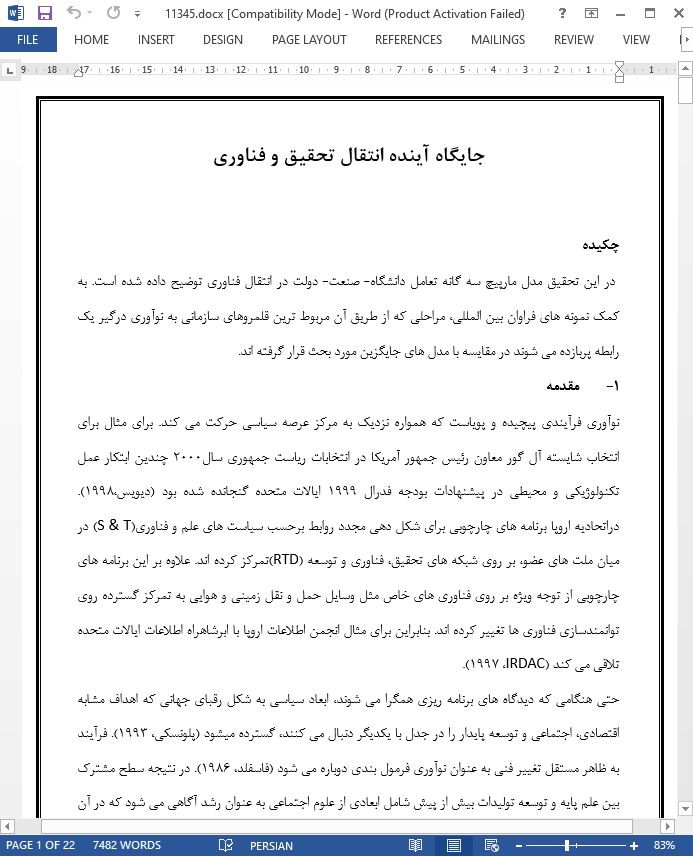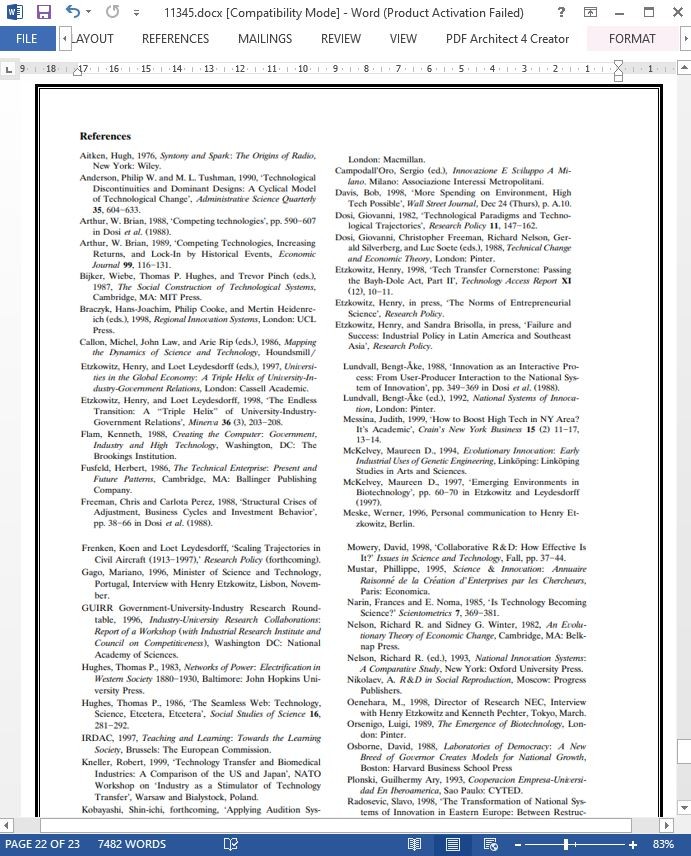
جایگاه آینده انتقال تحقیق و فناوری
چکیده
در این تحقیق مدل مارپیچ سه گانه تعامل دانشگاه- صنعت- دولت در انتقال فناوری توضیح داده شده است. به کمک نمونه های فراوان بین المللی، مراحلی که از طریق آن مربوط ترین قلمروهای سازمانی به نوآوری درگیر یک رابطه پربازده می شوند در مقایسه با مدل های جایگزین مورد بحث قرار گرفته اند.
1- مقدمه
نوآوری فرآیندی پیچیده و پویاست که همواره نزدیک به مرکز عرصه سیاسی حرکت می کند. برای مثال برای انتخاب شایسته آل گور معاون رئیس جمهور آمریکا در انتخابات ریاست جمهوری سال2000 چندین ابتکار عمل تکنولوژیکی و محیطی در پیشنهادات بودجه فدرال 1999 ایالات متحده گنجانده شده بود (دیویس،1998). دراتحادیه اروپا برنامه های چارچوبی برای شکل دهی مجدد روابط برحسب سیاست های علم و فناوری(S & T) در میان ملت های عضو، بر روی شبکه های تحقیق، فناوری و توسعه (RTD)تمرکز کرده اند. علاوه بر این برنامه های چارچوبی از توجه ویژه بر روی فناوری های خاص مثل وسایل حمل و نقل زمینی و هوایی به تمرکز گسترده روی توانمندسازی فناوری ها تغییر کرده اند. بنابراین برای مثال انجمن اطلاعات اروپا با ابرشاهراه اطلاعات ایالات متحده تلاقی می کند (IRDAC، 1997).
10- سازمان ثیم ایشو (theme issue)
نوشته های مختلف برای این شماره ازمیان بیش از یکصد مقاله ارائه شده در دومین کنفرانس مارپیچ سه گانه در دانشگاه نیویورک انتخاب شده است.
این شماره با مجموعه گزارش هایی در رابطه با پیشرفت های جاری در بخش های مختلف جهان اغاز میشود. قسمت دوم به نظریه پردازی اختصاص یافته است و در قسمت سوم به مسائل سیاست گذاری در سطح جهانی برمی گردیم.
بخش اول (سیستم جابجایی در گذار) با یک تاریخچه توسط مگنوس کلوفستن، دیلان جانزایوانز و کارینا شاربرگ با عنوان " توسعه قطب فنی لینکوپینگ- مطالعه طولی توسعه مارپیچ سه گانه در سوئد" آغاز میشود. منطقه لینکوپینگ اغلب به عنوان یک منطقه بسیار موفق در انتقال و تلفیق فناوری ذکر میشود. مقاله بر روی نقش دانشگاه ها در این فرآیند تاکید می کند.
ABSTRACT
The triple helix model of university-industrygovernment relations is explicated for the transfer of technology. Drawing upon a broad range of international instances, the stages and phases through which the institutional spheres most relevant to innovation are drawn into a more productive relationship are discussed in comparison to alternative models.
1. Introduction
Innovation is a complex and dynamic process that moves ever closer to the center of the political arena. For example, to better position Vice President Al Gore for the 2000 presidential election, several technological and environmental initiatives were included in proposals for the 1999 US federal budget Davis, 1998 . In the European . Union, the subsequent Framework Programs have focused on research, technology, and development RTD networks for reshaping relations in terms of S&T policies among the member states. Moreover, the Framework Programs have shifted from a specific attention to particular technologies, such as land and air transportation vehicles, to a broader focus on enabling technologies, e.g., the ‘‘European Information Society,’’ thus intersecting with the US information superhighway (IRDAC, 1997) .
10. Organization of the theme issue
The various contributions to this issue have been selected from the more than hundred papers presented at the Second Triple Helix Conference at the State University of New York at Purchase. The issue opens with a set of reports about ongoing developments in various parts of the world. A second part is devoted to theorizing, and in the third part we turn to policy issues at the global level.
Part I (‘‘The Transfer System in Transition’’ ) . opens with a case history by Magnus Klofsten, Dylan Jones-Evans, and Carina Scharberg entitled ‘‘Growing the Linkoping Technopole - A Longitudinal Study of the Triple Helix Development in Sweden.’’ The Linkoping region is often ¨ mentioned as an extremely successful region for technology transfer and technology integration. The paper highlights the crucial role of universities in this process.
چکیده
1- مقدمه
2- بنیان جامع مارپیچ سه گانه
3-توضیح مارپیچ سه گانه
4- حل مشکلات در مارپیچ
5- مدل سه گانه استاتیست (ساکن)
6- تکوین جاویژه (موقعیت مناسب)
7- روش از بالا به پایین در مقایسه با روش از پایین به بالا
8- تناقض های مارپیچی
9- انتقال بی پایان
10- سازمان ثیم ایشو (theme issue)
ABSTRACT
1. Introduction
2. The systemic substrate of the triple helix
3. Defining the triple helix
4. Resolving problems in the helix
5. Statist triadic models
6. Niche formation
7. Top down vs. bottom up
8. Helical paradoxes
9. The endless transition
10. Organization of the theme issue
- اصل مقاله انگلیسی با فرمت ورد (word) با قابلیت ویرایش
- ترجمه فارسی مقاله با فرمت ورد (word) با قابلیت ویرایش، بدون آرم سایت ای ترجمه
- ترجمه فارسی مقاله با فرمت pdf، بدون آرم سایت ای ترجمه


